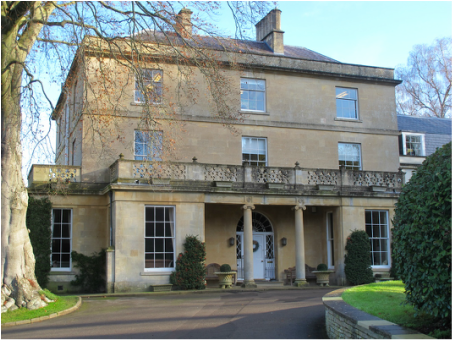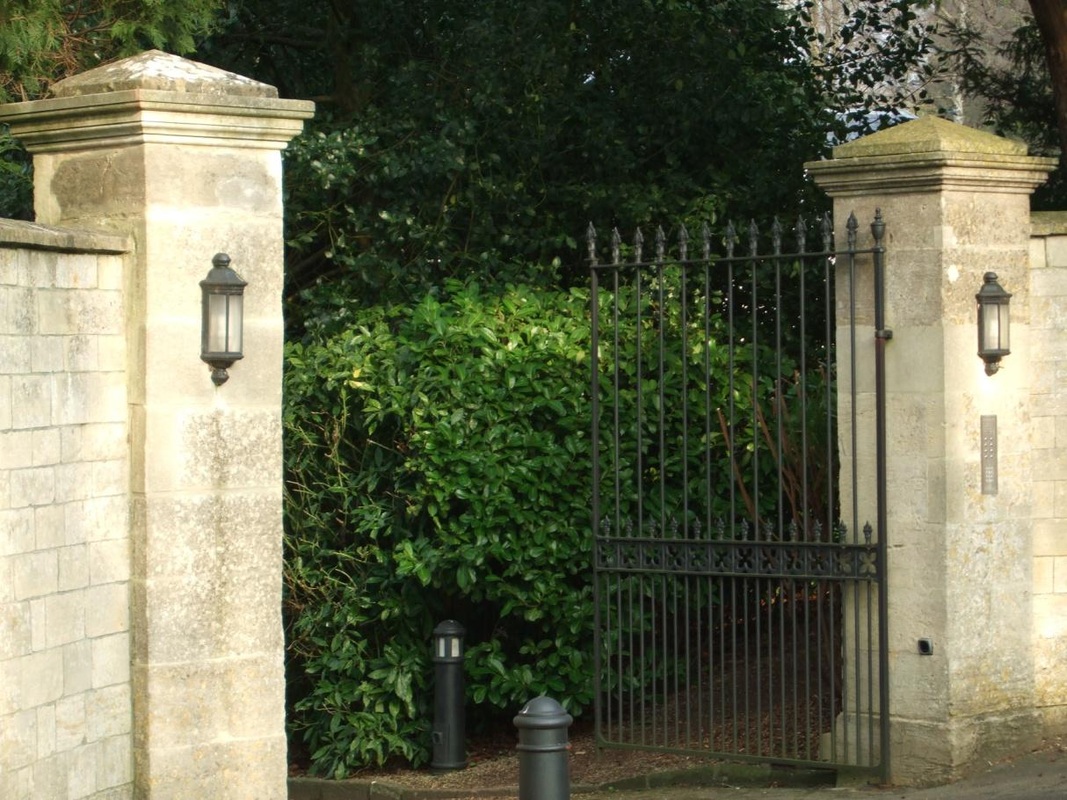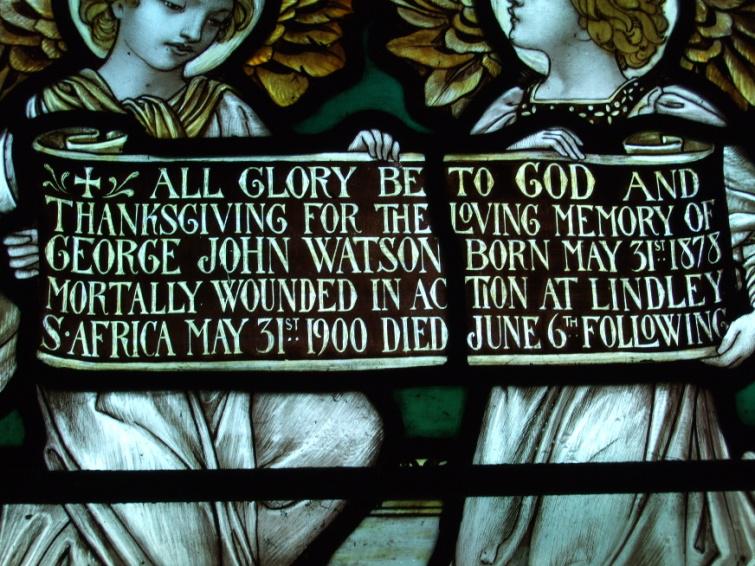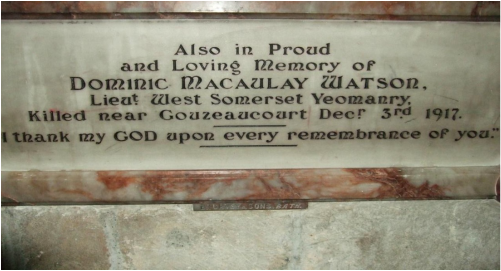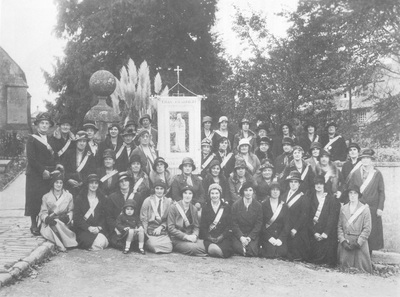As you enter Box along the A4 from Bath you cannot miss the imposing entrance to Box House. The house was built sometime between 1805 and 1807 by the then vicar, Isaac William Webb Horlock, as a replacement vicarage following a fire that destroyed the original. You can read more about these events at Horlock and Sudell family articles.
It has been suggested that the fire was an act of arson by Isaac William because it was not grand enough for his tastes. It is true that having grown up in his parental home, the Ashwick Hall Estate in Marshfield, he may well have developed a taste for the finer things of life. However, there is no evidence to support the view that he deliberately torched the vicarage. Regardless of this, when his son Holled Darrell resigned the living in 1873, he purchased Mead Villa as the replacement vicarage, and, it is assumed, he sold Box House. But who followed the Horlocks? The following attempts to answer that question.
It has been suggested that the fire was an act of arson by Isaac William because it was not grand enough for his tastes. It is true that having grown up in his parental home, the Ashwick Hall Estate in Marshfield, he may well have developed a taste for the finer things of life. However, there is no evidence to support the view that he deliberately torched the vicarage. Regardless of this, when his son Holled Darrell resigned the living in 1873, he purchased Mead Villa as the replacement vicarage, and, it is assumed, he sold Box House. But who followed the Horlocks? The following attempts to answer that question.
Early Residents
Some of the names of the earliest residents can be derived from the annual census:
1871 Rev Dr Holled Darrell Cave Horlock was the last of the Horlocks (builders of Box House) to live in Box House.[1]
1881 No residents recorded
Some of the names of the earliest residents can be derived from the annual census:
1871 Rev Dr Holled Darrell Cave Horlock was the last of the Horlocks (builders of Box House) to live in Box House.[1]
1881 No residents recorded
|
Christine Hippisley, 1891
Christine was the widow of John Hippisley, Lord of the Manor of Ston Easton, a small village about 8 miles from Bath. The family seat, Ston Easton Park, is a Palladian Mansion set in about 36 acres of parkland. On John Hippisley’s death, his estate passed to his son, Richard John Baynton Hippisley. On his death in 1956 the estate was sold to pay death duties. Why Christine moved to Box is unclear. However, she was born in Colerne and must have known the area well. Whatever the reason, she was able to live in style employing six household staff to look after herself and her daughter, Ivy. Christine and Ivy finally returned to Ston Easton. |
Amelia Watson, 1901
Amelia was born in Merthyr Tydfil and she had lived in many other places before she moved to Box House. In 1891 she was a widow living with her father, John Daniel Thomas, and a three year old son, Dominic Macaulay Watson; other members of the household included Amelia’s mother and five brothers and sisters. Her father was the High Bailiff at the County Court, a lucrative job enabling them to employ a coachman, cook, ladies maid and three other indoor staff.
By 1901 Amelia was living at Box House with a household staff of six servants including a governess. The census of that year records that she was living on her own private means. The previous year, her son George John Watson was mortally wounded in action at Lindley, South Africa, on the 31st May and he died on the 6th June. A memorial records this tragedy in a stained glass window in St Thomas à Becket.
Amelia was born in Merthyr Tydfil and she had lived in many other places before she moved to Box House. In 1891 she was a widow living with her father, John Daniel Thomas, and a three year old son, Dominic Macaulay Watson; other members of the household included Amelia’s mother and five brothers and sisters. Her father was the High Bailiff at the County Court, a lucrative job enabling them to employ a coachman, cook, ladies maid and three other indoor staff.
By 1901 Amelia was living at Box House with a household staff of six servants including a governess. The census of that year records that she was living on her own private means. The previous year, her son George John Watson was mortally wounded in action at Lindley, South Africa, on the 31st May and he died on the 6th June. A memorial records this tragedy in a stained glass window in St Thomas à Becket.
|
The uprising of the Boers had begun in 1899 in the area of the Orange River and a battalion of Fusiliers was dispatched there under the control of Lord Methuen.
The battle at Lindley lasted just 5 days in May 1900 when the 13th Battalion of the Imperial Yeomanry was surrounded by Boers. In command was Lt Col Spragge who, finding himself surrounded, sent a messenger requesting support. On the 31st May following the deaths of 17 men and 3 mortally wounded, Lt Col Spragge surrendered. He was taken prisoner, along with 400 other men. One of the three men wounded was Trooper George John Watson who died on the 6th June 1900. |
|
There
cannot be many other ranks that have a stained glass window
commemorating their life but it should be stated that the Imperial
Yeomanry was an elite volunteer force made up of largely upper
class young men.
By 1911 Amelia was living in Bathampton House, Bathampton. But tragedy was again to strike, when on the 3rd December 1917 her remaining son, Lt Dominic Macaulay Watson of the West Somerset Yeomanry, was killed near Gouzeaucoart, a village in Northern France, the scene of fierce fighting during the 1st World War. |
Thereafter the family left Box village. Amelia was living at 21 Royal Crescent, Bath when she died in September 1927 aged 75, and she left £88,900.
Rev Charles Richard Ward, 1911
After the Watson family, Box House was converted into a boarding school for boys run by Charles Ward (who describes himself as a Clerk in Holy Orders) and his wife Julia Beatrix. In 1911 there were ten boarders from 10 to 14 years of age, most of whom were many miles from home; one 10 year old boy came from France. One cannot help a feeling of sorrow for these boys; for some of them, the Western Front was their destiny, but probably they just wanted to go home.
After the Watson family, Box House was converted into a boarding school for boys run by Charles Ward (who describes himself as a Clerk in Holy Orders) and his wife Julia Beatrix. In 1911 there were ten boarders from 10 to 14 years of age, most of whom were many miles from home; one 10 year old boy came from France. One cannot help a feeling of sorrow for these boys; for some of them, the Western Front was their destiny, but probably they just wanted to go home.
The Hon Dora Marion Shaw Mellor, 1921
Anyone who has read PG Wodehouse's Jeeves and Wooster novels will have a mental picture of Bertie Wooster’s nemesis, aunt Agatha, who he describes as someone who could chew on broken glass and wore barbed wire next to her skin. If a description of Dora Shaw Mellor is accurate, she modelled herself on Bertie’s Aunt.
One Box resident of the time described Mrs Shaw Mellor as a formidable lady, large in stature, and since she always wore high heels required assistance to remain on her feet, particularly when visiting the Scout Hall in her capacity as President of the Guides Committee. The Shaw Mellors became resident at Box House from the early 1920s.
The Hon Dora Shaw Mellor, born 18th May 1873, was daughter of Richard Everard Webster and his wife Louisa Mary. She was a woman brought up in high Victorian society; her father was a distinguished lawyer and a staunch Conservative. In 1900 he was appointed Lord Chief Justice of England and made a baron. In 1913 he was raised to the peerage as Lord Alverstoke, 1st Viscount Alverstoke. Sadly Dora’s brother, who died of appendicitis, without issue, would have been the 2nd Viscount, but the title became extinct.
Dora was born and raised in Kensington and on the 19th, April 1902, she married Alfred Shaw Mellor, a medical practitioner from Paddington and subsequently lived there. Alfred was himself the son of a distinguished lawyer who was Master of the Crown Office. Almost certainly the two families knew each other socially.
Anyone who has read PG Wodehouse's Jeeves and Wooster novels will have a mental picture of Bertie Wooster’s nemesis, aunt Agatha, who he describes as someone who could chew on broken glass and wore barbed wire next to her skin. If a description of Dora Shaw Mellor is accurate, she modelled herself on Bertie’s Aunt.
One Box resident of the time described Mrs Shaw Mellor as a formidable lady, large in stature, and since she always wore high heels required assistance to remain on her feet, particularly when visiting the Scout Hall in her capacity as President of the Guides Committee. The Shaw Mellors became resident at Box House from the early 1920s.
The Hon Dora Shaw Mellor, born 18th May 1873, was daughter of Richard Everard Webster and his wife Louisa Mary. She was a woman brought up in high Victorian society; her father was a distinguished lawyer and a staunch Conservative. In 1900 he was appointed Lord Chief Justice of England and made a baron. In 1913 he was raised to the peerage as Lord Alverstoke, 1st Viscount Alverstoke. Sadly Dora’s brother, who died of appendicitis, without issue, would have been the 2nd Viscount, but the title became extinct.
Dora was born and raised in Kensington and on the 19th, April 1902, she married Alfred Shaw Mellor, a medical practitioner from Paddington and subsequently lived there. Alfred was himself the son of a distinguished lawyer who was Master of the Crown Office. Almost certainly the two families knew each other socially.
|
Mrs Shaw Mellor, characteristic of her breed, was at the centre of village life and involved with the Guides, the Church and the Mothers' Union. She was the mother of three daughters but her eldest daughter, Joan Marion, died in 1923, just 20 years old. The family had a memorial mounted close to the pulpit in her memory.
Also in the Church is an embroidered banner presented by the Mothers' Union reflecting the skill of among others Dora Shaw Mellor.[2] The Hon Dora Marion Shaw Mellor died in 1954 and her husband, Arthur, 13 years later in 1967. |
Shortly after the Shaw Mellors, the house, like many others, ceased to be a private residence. It became a hotel, the Clos du Roy restaurant, a training college and a conference centre, and is now rented out to private businesses.
Occupants of Box House
Compiled by Mike Lyons from the census, list of voters and Kelly's Directory
Compiled by Mike Lyons from the census, list of voters and Kelly's Directory
|
Date
1841 1851 1861 1871 1881 1891 1898 1901 1903, 07, 11, 15 1923, 25, 27 1931, 35, 39 1952 |
Name
H Horlock aged 30 years; James Gale, gardener, 16; Elizabeth Martin, 50 Holled Horlock, Vicar of Box, 44; Elizabeth Horlock, wife, 42; Elizabeth Horlock, daughter, 17; Elizabeth Phillips, housekeeper, 50; Elizabeth Shell, housemaid, 25; Emma Miles, cook, 21; Joseph Bartelo, footman, 52; Otto Hobbs, coachman, 19 Holled Horlock; Elizabeth Phillips, servant; Otto Hobbs, coachman, 28; John Harrison, footman, 40; Ruth Cole, housemaid, 36 Holled DC Horlock, vicar of Box, 64; Charlotte Horlock, wife, 27; Annette Horlock, daughter, 6; John Dean, servant/footman, 45; Sidney Mills, servant/groom, 25; Avira Skuse, domestic servant, 24; Sarah Clarke, domestic servant, 22; Emma Hobbs, domestic servant, 15; Ellen Fishlock, domestic servant, 16 Not stated Christine Hippisley, Independent means, widow, 57; Ivy Hippisley, daughter, 27; Emily Vining, visitor, 32; Margaret Vining, visitor; Mary Brown, visitor; Sarah Mallard, cook & domestic servant, 54; Lucy Vigar, housemaid, 40; Sarah Sell, housemaid, 21; Lizze Simmons, parlour maid, 22; Jane Hancock, kitchen maid, 16; Frederick Aust, coachman, 29 Mrs Amalie M Watson; Mrs Dominic Watson; George John Watson Mrs Amalie M Watson; George John Watson Reverend Charles Richard Ward, MA Mus Bac Alfred Shaw-Mellor, MA, MB, BCMRCS and Mrs the Hon Dora Maria Shaw-Mellor Alfred Shaw-Mellor, MA, MB, BCMRCS and Mrs the Hon Dora Maria Shaw-Mellor Alfred Shaw-Mellor, MA, MB, BCMRCS and Mrs the Hon Dora Maria Shaw-Mellor; Barbara Janet Shaw-Mellor; Box House Cottage separately owned by the Baxter family |
Sources
Ancestry.co.uk
Lindley-Military History Journal, Vol 13, No 6 www.samilitaryhistory.org/vol136si
Richard Kipling, Gouzeaucourt - The Somme to Gouzeaucourt, www.telelib.com/authors
Lord Alverstoke www.19thcenturyphotos
References
[1] See Horlocks
[2] See close-up of banner at St Thomas à Becket
Ancestry.co.uk
Lindley-Military History Journal, Vol 13, No 6 www.samilitaryhistory.org/vol136si
Richard Kipling, Gouzeaucourt - The Somme to Gouzeaucourt, www.telelib.com/authors
Lord Alverstoke www.19thcenturyphotos
References
[1] See Horlocks
[2] See close-up of banner at St Thomas à Becket
